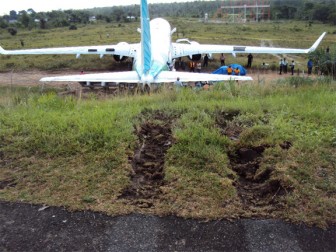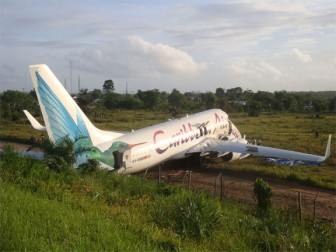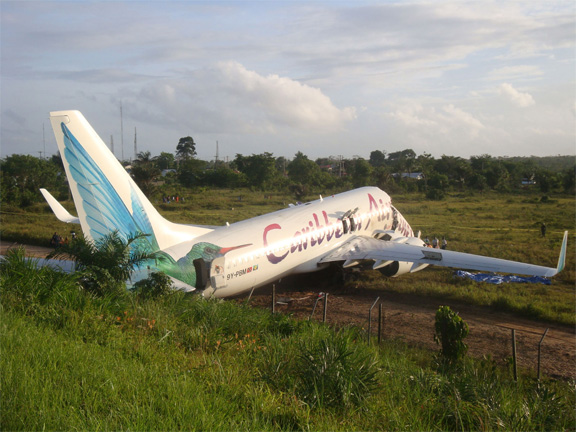Preliminary findings into last July’s crash landing of a Caribbean Airlines ( CAL) Boeing 737 at the Cheddi Jagan International Airport, Timehri points to pilot error as the pilot may have undertaken a “long landing” without having sufficient space to bring the aircraft to a safe stop.
The Guyana Civil Aviation Authority (GCAA), in a statement issued yesterday, said that Transport Minister Robeson Benn announced that the team investigating the non-fatal aircraft accident, which occurred at 1:30am on the morning of July 31 last year, is close to completing the factual information gathering phase of the investigation.
The aviation umbrella body said that the latter phase will be followed by an extensive and detailed analysis of the factual information, during which additional research and assistance and outside expertise from organizations such as the National Transport Safety Board (NTSB) of the United States of America and Caribbean Aviation Safety and Security Oversight System (CASSOS) may be required.

The GCAA further stated that at the end of the analysis phase, findings, conclusion and safety recommendations will be developed.
“At this stage, it appears that the primary contributing factor in this accident was that the aircraft made a long landing and touched down with insufficient runway remaining to come to a safe stop,” the GCAA revealed. It added that detailed analyses will examine several other aspects of the flight to identify any other possible contributing factors, in order to learn from the accident and to help identify any measures which may assist in the prevention of future occurrences.

Last month, Director General of Trinidad and Tobago Civil Aviation Authority Ramesh Lutchmedial said that simulations were being undertaken to determine what happened on the morning the aircraft broke in two after landing at Timehri. The aircraft, which bore registration 9Y –PBM and which was one of the newer models in the CAL fleet, was registered in Trinidad and Tobago. Lutchmedial said the simulations that were done were based on data retrieved from the flight data recorder (FDR) and the cockpit voice recorder (CVR).
Reports provided to this newspaper indicated that the aircraft touched the runway surface and soon after passenger accounts indicated that there was a sudden acceleration.
Moments after, the aircraft careened off the end of the main runway and broke in two.
The pilots reportedly shut down the engines during the traumatic moments, thereby preventing possible disaster.
The Wall Street Journal (WSJ) had reported that movable panels on the front and rear edges of the wings of the aircraft were apparently not extended as required before touchdown and crash investigators opined at the time that excessive speed and other suspected lapses in landing procedures caused the accident.
Preliminary findings, according to industry and government officials, pointed to pilot error rather than mechanical or other system malfunctions, the WSJ report said.
A source close to the investigations had also told Stabroek News days that that the preliminary investigations pointed to pilot error as the main contributing factor of the flight overshooting the runway.
The source had said that information from the flight recorders as well as marks on the runway confirmed that the jet touched down close to halfway along the length of the runway and Transport Minister Benn noted in subsequent media reports that camera footage substantiated this scenario.
The source also reported that investigations at the time revealed that the aircraft touched the runway surface between two taxiways, codenamed Alpha and Bravo, which aircraft such as the Boeing 737 would normally use to exit the runway after landing.
The WSJ reported that Director General of the GCAA Zulfikar Mohamed, in two separate interviews, said that the cockpit crew of Flight 523 reported no problems to air-traffic controllers on approach and data analyzed by investigators did not highlight any major system malfunctions. Mohamed played down theories that hydraulic or mechanical problems played a significant role in the accident.
The report noted that photographs taken after the accident did not show either sets of wing panels, called flaps and slats, extended on the plane.
Mohamed was also quoted as saying that investigators found the handle in the cockpit, normally used to extend the flaps, in the up position, which would be consistent with the panels not being extended. “The handles certainly may have been in a position they shouldn’t have been,” he said.
Guyana is formally in charge of the investigation, but much of the technical work relies on help from Boeing and the NTSB while the Trinidadian authorities are also providing support to the investigation.
There were reports at the time that weather conditions may have played a role in the accident but Mohamed and Benn later dismissed such suggestions, with both noting that conditions were above the minima during which such aircraft approach and depart an airport.
Several persons sustained injuries following the incident and the airline subsequently arranged to cover costs associated with treatment each passenger undertook. Noel Smith, a Guyanese passenger, sustained injuries to his right leg, which was subsequently amputated. His injuries were reported to have been the most severe compared with others.
Following the accident, Trinidadian Prime Minister Kamla Persad-Bissessar visited to commiserate with the victims.






